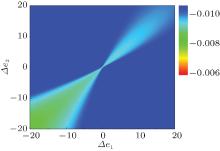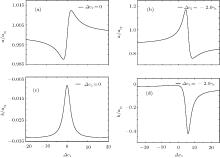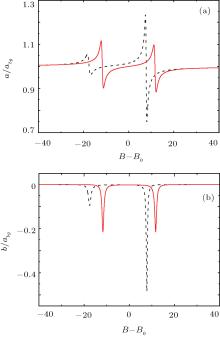†Corresponding author. E-mail: shlcong@dlut.edu.cn
*Project supported by the National Natural Science Foundation of China (Grant Nos. 10974024 and 11274056).
We investigate the two-color laser modulation of the magnetically induced Feshbach resonance. The two-color laser is nearly resonant with an optical bound-to-bound transition at the resonance position. The analytical formula of scattering length is obtained by solving the Heisenberg equation. The scattering length can be modified by changing the Rabi frequencies or optical field frequency. By choosing the suitable optical parameters, the two-body loss coefficient K2 can be greatly reduced compared to the usual single optical scheme.
In the past decade, the control of quantum degenerate gases of ultracold atoms is widely studied by exploiting collisional resonances.[1– 4] Many properties of ultracold gases depend on the s-wave scatting length.[5– 7] Magnetic-field-induced Feshbach resonance (MFR) is an effective tool and has been applied widely to the research of alkali atomic gases to control the interaction between atoms.[8– 11] However, MFR is limited in current experiments due to its relatively longer time scales and lower spatial resolution. An alternative way for modulating interatomic interactions is optical Feshbach resonance (OFR). In the OFR, a photoassociation light is employed to realize the transition from the continuum state of the colliding atomic pair to the excited molecular state.[12– 14] Fatemi and co-workers[15] observed optically induced Feshbach resonance in a cold (< 1 mK) sodium vapor. Based on the coherent free-bound stimulated Raman transition, Thalhammeret al.[16] investigated optical Feshbach resonance in the 87Rb Bose– Einstein condensate. OFR offers more flexible control over the interaction strength since the laser intensity can be changed on a small scale.[17– 19] However, OFR often suffers from rapid loss of atoms due to the light-induced inelastic collisions between atoms which can be characterized by the two-body loss coefficient K2.
Optical controls together with magnetic Feshbach resonances have been developed to modify the interatomic interaction. Bauer et al.[20, 21] explored how to control the scattering length near the magnetic Feshbach resonance by driving an optical-induced transition between the ground state and excited molecular state. They demonstrated that a single-color laser light can not only noticeably shift an MFR but also reduce the rate of particle loss. Mackie[22, 23] analyzed the role of quantum interference between magnetic and optical Feshbach resonances in cold atomic collision, and found that the quantum interference between photoassociation and Feshbach s-wave resonance could suppress inelastic and enhance the elastic scattering cross section. The improved quantum interference method was applied to the optical control with a wide tunability of scattering parameters.[24]
In our previous work, [25] we theoretically demonstrated that a dark state formed by the coherent superposition of two ground-states of a molecule induced by two optical lasers can modulate the MFR and suppress the inelastic loss. In the present work, we propose an alternative scheme for controlling the scattering length with a two-color optical field. We focus our attention on how the two excited molecular bound states are to be coupled to the ground molecular bound state by two optical fields. The quantum interference of two molecular excited states is used to modulate the MFR and reduce the inelastic loss. A many-body approach is used to describe the optical modulation of MFRs in Bose gas. The analytical expressions of the scattering length are obtained by solving the Heisenberg equation. The influences of the two-color optical field on scattering length and two-body loss-rate coefficient are discussed.
Our control scheme involving four electronic states is shown in Fig. 1, where |a〉 represents the scattering continuum state. The hyperfine interaction can couple the scattering continuum state |a〉 ⊗ |a〉 of the open channel to a bound vibrational state |g〉 in the closed channel. The atom– molecule coupling between the atom-pair state |a〉 ⊗ |a〉 and the ground state |g〉 , which is related to the Feshbach resonance, is described by the coupling strength α . The two-color laser field couples the ground state |g〉 to the excited electronic states |e1〉 and |e2〉 . The two-color laser field modulated by two coherent and simultaneous pulses can be expressed as[26]

where E1 and E2 are the field amplitudes, and ω 1 and ω 2 are the center frequencies of the fundamental fields. The Hamiltonian is written as[25]

where the optical field-system interaction Hamiltonian is given by

with 






The single-particle Hamiltonian containing kinetic operator and internal energy 

where mj = m(2 − δ aj) is the mass of atom in the state j and δ ij is the Kronecker symbol. The internal energy 

where μ j is the magnetic dipole moment. At B = B0, the |a〉 and |g〉 states are degenerate, and the energy of the |e1〉 (|e2〉 ) state is ħ ω e1 (ħ ω e2).
We now perform a transformation by ψ e1 → φ e1 eiω 1t and ψ e2 → φ e2 eiω 2t. By using the rotating wave approximation, equation (4) can be written as




Furthermore, by taking

equation (7) can be reduced to




where γ e is the decay rate resulting from spontaneous radiative decay from the |e1〉 and |e2〉 states to the states that are not included in the model. Δ g, Δ e1, and Δ e2 are given by



where μ ag = 2μ a − μ g, μ ae1 = 2μ a − μ e1, and μ ae2 = 2μ a − μ e2. The adiabatic elimination is performed by setting (d/dt)bg = (d/dt)be1 = (d/dt)be2 = 0. We can obtain the s-wave scattering length ã = a + ib by eliminating bg, be1, and be2 from Eq. (8), yielding


where abg is the background scattering length. For a pure Feshbach resonance (Ω 1 = Ω 2 = 0), equation (11) is reduced to the well-known result of a magnetically induced Feshbach resonance:

with the resonance width

where |α | is the Feshbach strength. The real part a of the scattering length is responsible to the mean-field energy. The imaginary part b of the scattering length describes the two-body loss by rate equation

with

where n = |Ψ a|2 is the peak density of the Bose– Einstein condensate (BEC). g(2) is the pair correlation function at zero relative distance. For a BEC with N atoms, g(2) = 1 − 1/N.
Using the above theoretical approach, we study the two-color laser modulation of the magnetically induced Feshbach resonance. Table 1 shows the parameters used in the calculation for the 87Rb which are taken from Ref. [22]. Figure 2 displays the imaginary part of scattering length as a function of the detuning Δ e1 and Δ e2. We take Ω 1 = 5γ e, Ω 2 = 3γ e, and B − B0 = 0.02 Gs in the calculation. By choosing the suitable Δ e1 and Δ e2, the imaginary part of scattering length b can be less than − 0.01. The suitable ranges of Δ e1 and Δ e2 are shown in Fig. 2.
| Table 1. Numerical parameters used in the calculation for the 87Rb which are taken from Ref. [21]. a0 is the the Bohr radius. The unit of μ ag/ħ , μ ae1/ħ , μ ae2/ħ , and γ e/ħ is MHz/Gs (1 Gs = 10− 4 T). The unit of |α | is mHz cm3/2. |
 | Fig. 2. The imaginary part of scattering length as a function of the detuning Δ e1 and Δ e2 in units of γ e. |
The change of scattering length with the photon detunings Δ e1/γ e is illustrated in Fig. 3. The parameters are chosen as before. For Δ e2 = 0, there is one resonance at Δ e1 = 0. For Δ e2 = − 2γ e the resonance takes place at Δ e1 = 5.0γ e. The imaginary part b displays a dispersive feature and the real part a is approximately described by the Lorentzian function. As shown in Fig. 3(b) and Fig. 3(d), the resonance position changes with Δ e2. When Δ e2 = − 2γ e, the minimum of imaginary part b/abg appears at Δ e1 = − 1.9γ e, which means that the two-body loss reaches its minimum value. For Δ e2 = 0, the imaginary part b/abg displays an opposite variation trend to that for Δ e2 = − 2γ e. The imaginary part b/abg = − 0.008 at Δ e2 = 0, which is less than the value obtained in a single-color field. This means the two-color field can enhance the scattering length and reduce the loss by adjusting the detunings Δ e1 and Δ e2.
Figure 4 shows the scattering lengths a and b in units of the background length abg as a function of the ratio K = Ω 1/Ω 2. Here B − B0 = 0.02 Gs. For Δ e1 = 2.5γ e, Δ e2 = − 2.5γ e, and Ω 2 = 2γ e, a resonance is created at K = 0.9. For Δ e1 = Δ e2 = 2.5γ e and Ω 2 = 2γ e, the real part a decreases rapidly with the increase of K. For different detunings, the imaginary part b displays two different variation trends. From Eq. (15), we can see that the two-body loss coefficient K2 is proportional to the absolute value of b. With the increase of K, the absolute value of b decreases up to 0.001. This means that we can reduce effectively the two-body loss coefficient K2 by adjusting the ratio of the Rabi frequencies Ω 1 and Ω 2.
To explore the magnetic field dependence of the scattering length for fixed optical field parameters, we calculate the scattering lengths a and b as a function of B. The Rabi frequencies are fixed at Ω 1= Ω 2 = 10γ e. As shown in Fig. 5, two resonances appear in a, and each of them displays approximately dispersive feature. From Fig. 5(a), we can observe two symmetrical splits around B0 when ω 1 = ω e1 and ω 2 = ω e2, which are the well– known Auter– Townes doublet. When ω 1 − ω e1 = − 5γ e and ω 2 − ω e2 = − 5γ e, the two resonance positions appear at B − B0 = 7.7 Gs and B − B0 = − 17.5 Gs. In Fig. 5(b), the imaginary part b also displays two resonances. For different detunings, their heights, widths, and positions are quite different. When ω 1 = ω e1 and ω 2 = ω e2, we observe two symmetrical resonances at B − B0 = 11 Gs and B − B0 = − 11 Gs. When ω 1 − ω e1 = − 5γ e and ω 2 − ω e2 = − 5γ e, two resonances appear at B − B0 = 7.7 Gs and B − B0 = − 17.5 Gs. The bound-to-bound coupling can modify the energies of the bound levels. By changing the Rabi frequencies, the bound level crosses the atomic threshold of a different hyperfine level and new Feshbach resonance can be created. With the shift of the bound level the crossing position is also changed which means that by adjusting the parameter of the light, we can modify the Feshbach resonance.
We have demonstrated theoretically that a two-color field can be successfully used to modulate magnetically induced Feshbach resonance in Bose gas. Two-color field coupling the ground state and excited state can change the scattering length and reduce the two-body loss coefficient K2. The analytical expression of scattering length is derived by solving the Heisenberg equation. The scattering length can be modified by changing the Rabi frequencies or the frequency of the optical field. By choosing the suitable optical parameters, the two-body loss coefficient K2 can be greatly reduced compared to the usual single optical scheme.
| 1 |
|
| 2 |
|
| 3 |
|
| 4 |
|
| 5 |
|
| 6 |
|
| 7 |
|
| 8 |
|
| 9 |
|
| 10 |
|
| 11 |
|
| 12 |
|
| 13 |
|
| 14 |
|
| 15 |
|
| 16 |
|
| 17 |
|
| 18 |
|
| 19 |
|
| 20 |
|
| 21 |
|
| 22 |
|
| 23 |
|
| 24 |
|
| 25 |
|
| 26 |
|






